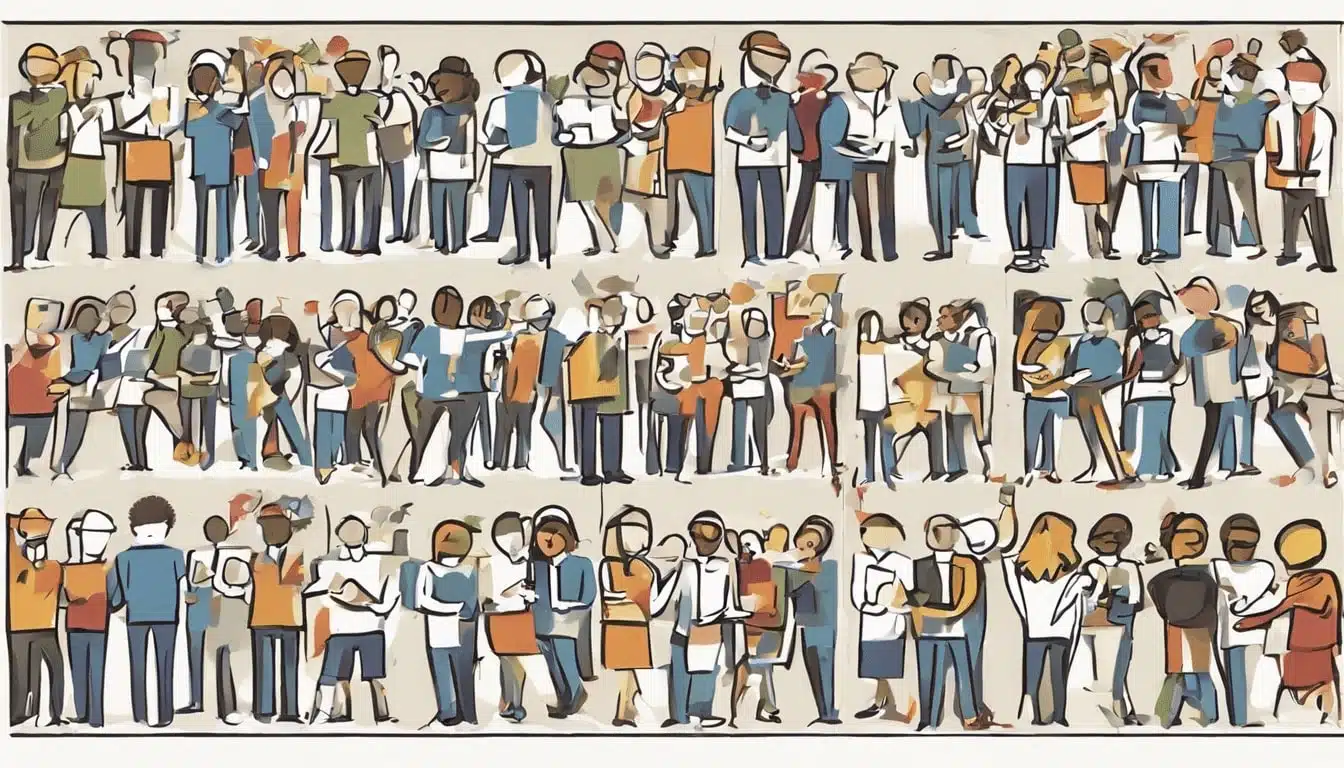You found our guide to team building social calendars.
Team building social calendars are strategic plans that businesses use to foster a sense of community and improve collaboration among team members. These calendars are full of fun social events coworkers can do together to deepen relationships at work. Rather than being one-off outings or experiences, these calendars provide an ongoing plan to promote camaraderie among team members. These programs enhance employee engagement, boost morale, and promote a positive work culture. These programs are also known as “collaborative team calendars,” “group cohesion plans,” and “corporate social calendars.”
These programs are types of team building events and activities and ways to connect employees in the workplace, and are similar to work social event ideas.

This article covers:
- What is a team building social calendar for work?
- What is teambuilding.com’s Social Calendar?
- How to create a team building social calendar for work
- List of team building social calendar ideas
- Reasons to plan a team building social calendar for work
The post also touches on:
- collaborative team calendars
- corporate social calendars
- corporate team building calendars
- engaging team building calendars
- group building social calendars
- group cohesion plans
- workplace events calendars
Let’s get to it!
What is a team building social calendar for work?
A social calendar for work is a series of events that help teammates get to know each other beyond the scope of work. These calendars contain various activities and events that foster teamwork, communication, and camaraderie among team members. These initiatives help strengthen relationships, boost morale, and improve overall collaboration within the team.
By including a mix of social events, workshops, volunteer opportunities, and team building exercises in the calendar, teams can bond outside of work responsibilities.
Investing time in planning and executing a well-thought-out team building social calendar can increase employee satisfaction and retention. These events provide a break from the routine work environment, allowing team members to relax and connect on a more personal level.
Additionally, these corporate social calendars often include activities that encourage creativity, problem-solving skills, and trust among team members. Understanding the concept of team building social calendars is essential for nurturing a positive work culture and fostering strong relationships within the team.
What is teambuilding.com’s Social Calendar?
Social Calendar by teambuilding.com is a product that provides companies with high-quality socials regularly.
You choose the frequency of these socials: monthly, bi-monthly, or weekly.
Then, creative experts curate a balanced calendar of events that helps your employees have fun and bond. These events are more relaxed in structure compared to formal team building experiences, and employees can stay and socialize for a while or drop in for as little as ten minutes.
A host travels to your office regularly with all the materials needed for the activities. These professionals facilitate games and activities if your group needs a nudge to participate and connect.
The perks of this facilitated Social Calendar versus DIY-ing your own version is that the package saves you time and money, as you do not need to plan, set up, run, and clean up activities, nor do you have to buy activity supplies that you will only use once. You also benefit from the knowledge, talent, and skill of team building experts with extensive experience connecting, uplifting, and engaging workplaces.
Learn more about Social Calendar.
How to create a team building social calendar for work
Here are steps for creating a social calendar for work.
1. Choose a goal
The overall objective of hosting ongoing events in the office is to help employees socialize and have fun. However, it can be helpful to select secondary goals, such as improving cross-departmental collaboration, sparking creativity, improving communication, and testing problem-solving skills. These ideas will inform your activity selection and the way you measure results. It can also help to select measurable metrics for these events, such as attendance or employee sentiment, and choose numbers you would like to reach by the end of the program.
2. Determine frequency
Early in the planning process, decide how often you would like to meet. Frequency can depend on your employees’ schedules, budget for activities, and your bandwidth as an organizer. Once a month is an excellent starting cadence, and you can scale up as your success grows. Not every employee will be able to attend every gathering, so it is a good idea to hold events semi-regularly so that if an employee is too busy on event day, another opportunity is around the corner.
Get our free team building toolbox
- icebreaker games
- bingo cards
- DIY guides
 by teams at FedEx, Amazon, Deloitte and 73,930+ others
by teams at FedEx, Amazon, Deloitte and 73,930+ others

3. Set a budget
Most companies have budgets for team building, employee engagement, or staff outings. If a budget exists, then decide how much of it should go to socials. If not, then propose an amount to spend on these events.
Many companies spend between $30 to $100 per employee event, sometimes more, depending on how frequently these events occur. It is usually easier to set a budget for the entire year with an average spend.
You may spend more on some events than others. For example, one month, you may opt for a free scavenger hunt with snacks, while another month, you budget for terrarium building. Socials do not have to cost much to be effective. However, you should secure some funds for this purpose.
Read more about team building budgets.
4. Ask your staff for input
One of the best ways to ensure your team is enthusiastic about your social calendar is to involve them in creating it. You can take a survey, consult your culture committee, or meet with coworkers to gauge interest and brainstorm ideas. It is a good idea to gauge how often employees would like these events to happen and what activities would most appeal to your coworkers. When your team has a say in shaping the program, they will feel a sense of ownership over it and will be more likely to participate.
5. Prepare activities
Once you have the basics of your program down, it is time to plan activities. While you only need to work out some details, it is good to think ahead and outline multiple months of activities. Even if you do not map out your entire year, plot ahead for the next two quarters. This way, you can balance the types of activities and budget accordingly and start preparing early. This foresight also gives you more runway to promote your events and build anticipation among your staff.
As the event approaches, get a room or venue, gather your supplies, plan the event flow, recruit teammates to help you if needed, prepare instructions, and get ready to engage your group with fun projects and exercises. Preparing icebreaker questions or games to help groups socialize is also a good idea.
Here are examples of icebreaker games.
6. Introduce the concept
In addition to announcing and promoting events individually, it is a good idea to introduce the overall concept of your team building social calendar to your group. This conversation sets up the expectation that events will be ongoing and there will be many chances to join in on the fun. Also, share the program’s potential benefits, explaining that socials improve camaraderie, collaboration, and employee engagement. All-staff meetings and company newsletters are ideal for sharing your program.
7. Build buzz for events
Workplace events calendars work best when employees look forward to upcoming events. As each social approaches, build anticipation. Be sure to announce the social at least two weeks in advance, a month if possible. You can hang posters in your office, mention the event in meetings, send email invites and reminders, post in companywide Slack channels, and put the event on your cloud calendar.
Promoting the event in a variety of ways is a good idea, as the repetition and different platforms will expand your reach and catch the attention of more employees. Also, encourage RSVPs so that you know how many folks to expect. These steps will improve your chances of having the most employees attending your events.
8. Measure results
Measuring your impact is one of the most critical steps in your social calendar. Leaders like to see the results of their investment, and gathering data about your events can help justify the spending. It is a good idea to keep track of the number of employees who attend, and you can send out surveys to gauge employee sentiment about the events.
You can also tie results into HR metrics.
List of team building social calendar ideas
Here is a list of different types of social calendar events and ideas for building a team building calendar.
1. Cultural Experiences
Cultural experiences are crucial for building teams’ social calendars. These activities allow for exploring different perspectives, traditions, and art forms. By participating in cultural activities as a team, members can connect over shared experiences and develop a deeper understanding of various cultures. These experiences can stimulate creativity, empathy, and open-mindedness among team members, leading to stronger relationships and better collaboration within the group.
Examples:
- International potluck lunch
- Cultural dance lesson
- Team travel scrapbook
- Foreign film screening
- Collaborative playlist
- Global trivia challenge
- Party for a lesser-known, non-mainstream holiday
Attending cultural events can also improve communication skills by promoting active listening and effective communication across cultural boundaries. Moreover, exposure to various cultural practices can spur innovation and inspire new ideas within the team. Embracing cultural experiences creates a more inclusive work environment where each team member feels valued and respected for their unique background.
Here are more culture-building ideas.
2. Food Oriented Events
Events centered around food make a great addition to team building calendars. These socials allow team members to bond over cooking classes, food tastings, or team lunches. Sharing a meal can help build camaraderie and boost morale. Snacking together allows individuals to unwind and enjoy each other’s company outside of work.
Examples:
- Pancake art
- Hot sauce-tasting challenges
- Coffee crafting classes
- Mystery ingredient cookoffs
- Secret Santa-style snack swaps
Including food-focused events in team building activities can enhance relationships and communication within the team. By attending these events, employees can learn about each other’s preferences while having fun together.
Blending food with team building offers a unique way for teams to connect, try new things, and strengthen their bonds in a relaxed setting.
Here are food-tasting events for teams.
3. Friendly Networking Sessions
Networking sessions offer valuable chances for team members to connect with professionals in their field, exchange ideas, and build relationships that can benefit their careers. Friendly networking sessions are casual and occur between colleagues rather than strangers from different organizations. These events usually have a structure of activities or conversation starters that encourage mingling and are excellent additions to corporate team building calendars.
For example:
- Speed dating – employees talk to different coworkers for three minutes each before switching
- Human Bingo – players try to call Bingo by matching coworkers to descriptions on the card
- Icebreaker questions – attendees have an icebreaker question around their necks, and other guests must answer the question in conversation or on a sticky note
These events can make introductions, break down barriers, and encourage a more friendly, open atmosphere in your office.
Here are more networking activities.
4. Creative Activities
Participating in creative activities is an excellent method of promoting teamwork and enhancing morale within a group. Activities like art classes and DIY workshops offer team members a chance to find inspiration, unwind, collaborate, and get to know each other on a more personal level. These activities allow individuals to display their unique talents and strengths outside of work, fostering an appreciation for the diverse skills present within the team.
For example:
- Coloring in adult coloring books
- Painting clay pots
- Compiling vision boards
- Creating a team mural
- Folding origami
- Making terrariums
Promoting creativity among team members through diverse activities can result in increased innovation and new perspectives within the group. These exercises enable individuals to unleash their imagination and tackle challenges from various viewpoints. Embracing creativity as part of group building social calendars can lead to a more motivated workforce prepared to handle any project that comes their way.
5. Health and Wellness
Most modern workplace events calendars feature several employee wellness events. Activities focused on health and wellness help in team building by enhancing the physical and mental well-being of team members. These activities include group workouts, yoga sessions, mindfulness workshops, and healthy cooking classes. By giving importance to health and wellness, teams can increase morale, productivity, and a sense of camaraderie. Encouraging participation in these activities improves overall health and strengthens teamwork and collaboration within the organization.
Examples:
- Art therapy workshop
- Healthy meal prep cooking class
- Yoga or pilates class
- Meditation and mindfulness session
- Group journaling
- Self-help book club
Encouraging a focus on health and wellness in the team building social calendar can lead to a more balanced work environment where employees feel supported in their overall well-being. Prioritizing these activities shows that the organization values employees’ health and nurtures a positive workplace culture. By including health-focused events in the social calendar, teams can bond over shared experiences that promote healthy habits, resulting in improved morale and higher engagement.
Check out more workplace wellness activities.
6. Skill Building Activities
Activities that help build skills are crucial parts of team social schedules. Taking part in activities that push individuals to learn new skills promotes personal development and enhances the team dynamic. These events can improve morale and productivity in the workplace by encouraging a culture of continuous learning and growth.
Whether attending a workshop on communication strategies, playing problem-solving or survival games, or practicing public speaking, these activities offer team members opportunities to grow together and improve their ability to work collaboratively. You can also hold activities to improve general skills.
For example:
- Storytelling workshops
- Financial health workshops
- Organizing workshops
- Art lessons
- Improv sessions
Including educational workshops in a team building social calendar allows organizations to invest in their employees’ professional development while strengthening interpersonal connections.
By adding skill-building activities to the social calendar, teams can enhance their capabilities and collaborate more efficiently towards shared objectives.
Here are more professional development ideas.
7. Community Outreach
Engaging with the local community can have a positive impact on your employees and the surrounding neighborhood. Events can include volunteering, organizing, or supporting local causes.
For example:
- Making blankets for shelter pets
- Wrapping holiday toys for children in need
- Creating cards to send to retirement homes
- Competing in online games that gather donations for real charities
- Cleaning up the neighborhood
By embracing community outreach activities, teams can strengthen their bonds while giving back to those around them. These special socials foster a sense of unity and purpose among team members, creating a shared experience that extends beyond the workplace. Team building social calendars benefit from including community outreach events as they promote teamwork, empathy, and a sense of social responsibility.
Check out more charity team building ideas.
8. Celebrations and Parties
Team building social calendars often feature celebrations and parties as essential elements. These gatherings allow team members to bond, unwind, and enjoy themselves in a setting different from the usual work environment.
Whether it is a festive party, a significant milestone celebration, or a themed gathering, these occasions help reinforce relationships and uplift team spirit. By promoting camaraderie and establishing shared memories, these events contribute to a harmonious and positive work atmosphere.
Remember that you do not need an official occasion like a birthday, project milestone, or national holiday to throw a celebration! Observing unique or lesser-known occasions can create an insider culture.
Examples:
- Talk like a Pirate Day
- Employee Appreciation Day
- Work Besties Day
- Learn a Random Skill Day
- Area Code Day (for example, if your area code is 315, have a party on March 15)
Besides providing a respite from the daily work grind, including celebrations and parties in collaborative team calendars can also improve communication skills. Low-pressure party banter helps members better understand each other’s personalities, interests, and capabilities.
Check out more office party ideas.
9. Sporting Events
Sporting events are a great addition to team building social calendars. These events offer a fun and engaging way for team members to bond outside the work environment. Attending games together can create shared experiences and memories that strengthen relationships and unity within the team. Whether cheering for a local team or participating in company sports leagues, sporting events provide a relaxed setting for colleagues to connect beyond their professional roles.
By including sporting events in the social calendar, teams can foster camaraderie and enhance teamwork skills in a laid-back atmosphere.
You can create a DIY sporting event by playing fun field day games.
Reasons to plan a team building social calendar for work
Here are some ways social calendars can improve your workplace atmosphere and company culture and drive business results.
1. Return to the Office
According to recent findings from Gallup, engagement has 3.8x as much influence on employee stress as work location. Many workers are reluctant to return to the office. However, you can make the office more welcoming by offering employee programming. Connecting and reconnecting with peers is an excellent reminder of the perks of working in person. Building relationships with peers can make transitioning into the office easier and may even get employees excited about the change.
Check out more return to the office ideas.
2. Morale Raising
No matter how strong your internal culture may be, outside influences, like news of layoffs or global events, can challenge your office’s emotional equilibrium. You can reclaim control of your team’s morale, reassure team members, and regularly bring much-needed joy into your workplace through these group cohesion plans. Human connections and work friendships can be a powerful mood improver, as can breaks from work.
Read more about boosting employee morale.
3. Company Culture and Employee Engagement
Shared experiences are the basis of a cohesive culture. These events give employees a reason to gather and topics to talk about long after the occasion ends. The frequency of the socials transforms team building from a random occasion into a steady, anticipated workplace tradition. When gatherings happen regularly, they become part of the company’s social fabric and general culture rather than feeling like random occasions or special treats.
Learn more ways to improve company culture.
4. Workplace Wellness
Social wellness is an often overlooked aspect of personal and professional health. The U.S. Department of Health and Human Services identifies “Connection and Community” as one of the Five Essentials of Workplace Mental Health and Well‑Being. Office socials can boost employees’ sense of belonging and social support to thrive socially, emotionally, and mentally at work.
5. Cross Departmental Interaction
Socials can appeal to various interests and personality types to bring your workforce together to bond over non-work topics. Some departments may cross paths rarely and may not need to interact, yet employees can still benefit from getting to know these colleagues. In traditional team building events, participants may only interact with a handful of new coworkers. However, in more casual socials, attendees can cross paths and strike up conversations with a broader selection of their peers.
6. Orientation and Onboarding
Suppose you need an easy way to welcome interns and new hires to your organization. In that case, holding regular social events is a great move, especially if you have a large company and regularly hire new staff. These socials can help new hires meet coworkers and assimilate into the office. Socials are great for introducing team members to your culture and accelerating bonding.
Check out more employee onboarding activities.
7. Impactful Team Communication
A Harvard Business Review study states that socializing between team members improves communication patterns by more than 50%. Socials can be “team building in stealth mode.” Employees come for fun, exciting activities and a break from the workday routine but leave with improved skills, connections, confidence, and camaraderie. Having non-work conversations can improve professional interactions as well.
Here are more internal communication tips.
8. Employer Branding
Socials can contribute significantly to employer branding. Firstly, employee satisfaction is likely to increase, and you can earn a reputation for being a fun, social workplace that cares about employee happiness. Introducing engaging team building calendars can provide proof of these claims through photo opportunities. You can capture photos or videos at these socials to share on social media, email newsletters, and the company website.
Final Thoughts
Creating an effective team building social calendar requires careful planning and consideration of various factors, such as company culture, employee preferences, and logistical constraints. It’s important to strike a balance between fun activities that employees look forward to and those that contribute to their professional development. Remember that the ultimate goal is to foster a sense of community within the workplace while promoting productivity.
Next, check out our posts on culture committee best practices and culture committee ideas.




